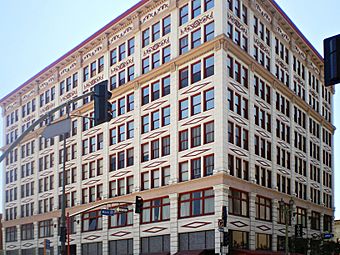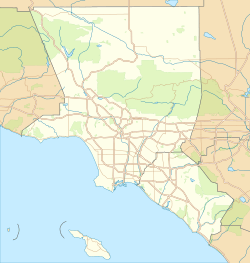San Fernando Building facts for kids
Quick facts for kids |
|
|
San Fernando Building, The
|
|

San Fernando Building, 2008
|
|
| Location | 400-410 S. Main Street, Los Angeles, California |
|---|---|
| Built | 1906 |
| Architect | Blee, John F., et al. |
| Architectural style | Italian Renaissance Revival |
| NRHP reference No. | 86002098 |
| Added to NRHP | July 31, 1986 |
The San Fernando Building is a beautiful building in the Italian Renaissance Revival style. It was built in 1906 at 400–410 S. Main Street in the Historic Core district of downtown Los Angeles, California. The building was added to the National Register of Historic Places in 1986. Later, in 2000, it was changed into modern apartments called lofts. In 2002, it was named a Historic-Cultural Monument, which means it's an important historical place.
Contents
Building Design and History
James Boon Lankershim (1850-1931) was a very rich farmer. His father owned a lot of land in the San Fernando Valley a long time ago. James Lankershim hired an architect named John F. Blee to design this building.
Construction Details
The San Fernando Building cost about $200,000 to build. It opened in 1907. At that time, it was thought to be one of the best office buildings in Los Angeles. The main entrance area, called the lobby, has a very tall ceiling, about 22 feet high. The outside of the building has fancy decorations. These include detailed cornice work and panels with a diamond pattern. The building first had six stories. In 1911, two more stories were added. These new stories were designed by Robert Brown Young & Son.
Early Activities in the Building
The San Fernando Building has a long and interesting history. It was known for many different kinds of businesses and activities.
- In 1907, the Los Angeles Realty Board moved into the building. This group helped make sure real estate deals were fair.
- In 1913, doctors and surgeons created the city's first shared telephone system here. This system helped doctors and patients talk to each other all day and night.
- The California Film Exchange was also in the building. This was where early Hollywood movies were stored. In October 1913, a fire broke out. It destroyed about 150 movies. The fire started because a motor got too hot. This led to two explosions when the flames reached chemicals. After this fire, people wanted to stop storing flammable films in downtown office buildings.
- In 1917, a group called the "Half Century Association" started here. Their goal was to help older people find jobs. They wanted to break down the idea that people were too old to work.
- During World War I, the U.S. Army had its recruiting station in the building. Many people came to sign up for the Army here. The building was used as an Army recruiting center again during World War II.
Historic Recognition
The San Fernando Building is important to the history of Los Angeles. It was added to the National Register of Historic Places in 1986. This is a list of places across the country that are important to American history. In 2002, the Los Angeles Cultural Heritage Commission also named it a Historic-Cultural Monument. This means it's a special landmark in the city.
Changing to Loft Apartments
In the 1980s and 1990s, the area around the San Fernando Building was not doing very well. In 1998, a company called Gilmore Associates decided to make a change. They planned to turn the San Fernando Building and two other old buildings nearby into 230 loft apartments.
The Vision for Downtown
At first, some people were unsure about this plan. They thought the area was too empty and didn't have enough stores. But the Los Angeles Times newspaper thought the project could really change downtown. They wrote that the developer, Tom Gilmore, was working on an amazing project. He was bringing new life to a whole block of buildings.
The Loft Conversion
The San Fernando Building was the first of the three buildings to open as lofts. This happened in August 2000. By March 2001, almost all the apartments were rented. The new apartments were large and open, with high ceilings. They had many windows, which let in a lot of natural light. An architect named Wade Killefer designed the changes. He said that the buildings were perfect for homes because of their many windows and high ceilings. All these converted buildings together became known as the Old Bank District lofts.
New Businesses and Community
Today, a popular bar and restaurant called Baco Mercat is on the ground floor of the building. This is the same spot where the Army's recruiting station was during World War I. The changes to the area have brought new businesses and people. This has helped to make downtown Los Angeles a more lively place.





